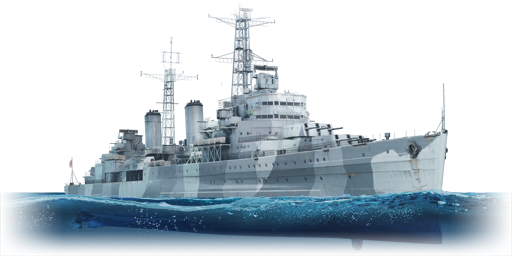



HMS Belfast (C35) was the ninth of ten Town-class light cruisers and the second of the Edinburgh sub-class. She was laid down on 10 December 1936 at Harland & Wolff Shipyard in her namesake city in Northern Ireland, and commissioned three years later on 5 August 1939.
At the start of World War II in September 1939, Belfast was assigned to perform convoy raiding against Germany. After suffering minor damage from mines in November, Belfast was sent back for repairs and refit until 1942, when she was reassigned to escort Atlantic convoys. Belfast took a key role during the Battle of North Cape on 26 December 1943, where she spotted and tracked the German battleship Scharnhorst, which led to the latter's sinking. Belfast later participated in D-Day and Pacific theatre operations. After the war, she served in bombardment roles in the Korean War in 1952. Unlike most of her sister ships that were either sunk during the war or scrapped thereafter, Belfast was modernized in 1959. However, due to obsolescence, Belfast was decommissioned just four years later in 1963. Following a campaign to preserve the ship headed by the HMS Belfast Trust, Belfast was transferred to the Trust and later the Imperial War Museum to serve as a museum ship on 21 October 1971. She was moored on the River Thames near Tower Bridge in London and remains a popular tourist attraction to this day.
HMS Belfast was introduced in Update 1.93 "Shark Attack". She is presented in the final 1959 configuration as she appears today. As such, she does not have the torpedo armament originally fitted to all Town-class cruisers, but has much improved anti-aircraft armament. Much like her sister ships, the Belfast has good broadside firepower, but is held back by the lack of AP shells. Due to this, she primarily excels at mid-to-close range engagements where her SAP shell is effective, but is vulnerable to returning fire due to the exposed crew compartments on the deck being an easy target.
| Ammunition | Type | Armor penetration (mm) at a distance: | |||||
|---|---|---|---|---|---|---|---|
| 1000 m | 2500 m | 5000 m | 7500 m | 10000 m | 15000 m | ||
| HE | 37 | 37 | 37 | 37 | 37 | 37 | |
| SAPBC | 216 | 185 | 141 | 106 | 78 | 61 | |
| HE-TF | 37 | 37 | 37 | 37 | 37 | 37 | |
| HE-VT | 37 | 37 | 37 | 37 | 37 | 37 | |
| Ammunition | Type | Armor penetration (mm) at a distance: | |||||
|---|---|---|---|---|---|---|---|
| 1000 m | 2500 m | 5000 m | 7500 m | 10000 m | 15000 m | ||
| HE | 20 | 20 | 20 | 20 | 20 | 20 | |
| SAP | 101 | 83 | 60 | 44 | 33 | 26 | |
| HE-TF | 20 | 20 | 20 | 20 | 20 | 20 | |
| HE-VT | 20 | 20 | 20 | 20 | 20 | 20 | |
| Belt | Belt filling | Armor penetration (mm) at a distance: | |||||
|---|---|---|---|---|---|---|---|
| 10 m | 100 m | 500 m | 1000 m | 1500 m | 2000 m | ||
| HEFI-T | 6 | 6 | 5 | 5 | 4 | 4 | |






 2 x (450 / 600) %
2 x (450 / 600) % 
 2 x 190 %
2 x 190 % 

Seakeeping |
|---|
Unsinkability | |
|---|---|
Firepower | ||
|---|---|---|